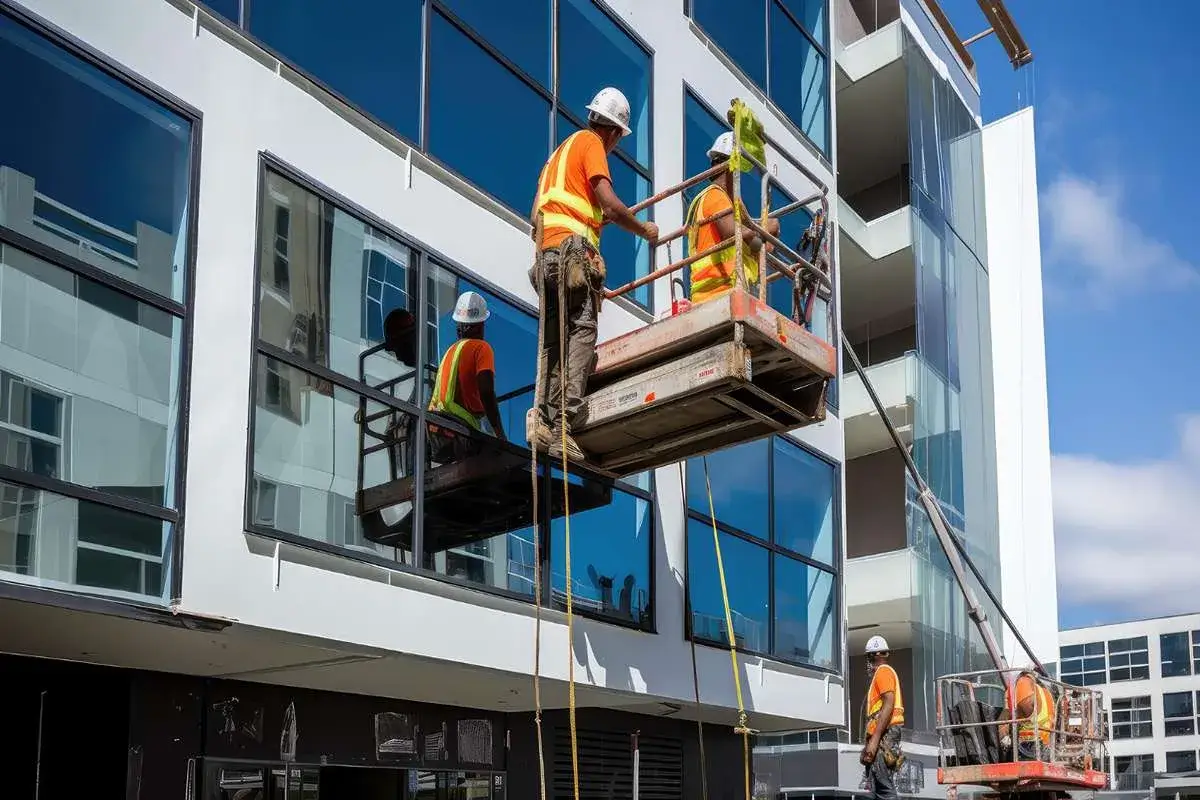What Repairs or Upgrades Are Necessary for Commercial Buildings?

When it comes to commercial buildings, whether it’s a retail plaza, office complex, medical center, or a multi-purpose space, we all know that no two buildings can be the same. The only similarity in such structures is that they require care. Therefore, if you own or manage a commercial property, you need to be super active to watch for repairs and upgrades required. Fixing wear and tear in good time helps you avoid unnecessary long-term expenses.
What Are Essential Commercial Building Repairs
In a commercial building, essential repairs are those that directly impact safety, structural integrity, daily operations, or code compliance. These aren’t cosmetic fixes or optional improvements; they’re the must-do repairs that make your building a fine and safe place. Some essential repairs are:
Roof Repairs
The roof is your building’s first defense against the weather. Even minor damage to the roof can lead to major consequences. The following roof repairs should be highly prioritized:
- Fixing leaks or punctures in the membrane
- Replacing damaged or missing flashing
- Repairing ponding areas where water collects
- Sealing cracks and worn-out seams
It is a fact that roofing issues are among the top causes of building water damage, and repairs can often prevent it if done on time.
HVAC Repairs
Heating, ventilation, and air conditioning systems are essential for comfort and air quality, especially in offices, hospitals, and retail centers. The HVAC systems may need repairs like:
- Replacing broken fan motors or compressors
- Repairing ductwork leaks
- Calibrating faulty thermostats
- Restoring heating or cooling when units fail
A malfunctioning HVAC system can drive tenants away, lead to employee discomfort, and even cause health complaints. In many areas, certain indoor temperature ranges are required by local regulations, so the unit should work properly.
Plumbing Repairs
Leaks, blockages, or burst pipes can grind business operations to a halt and create health hazards. The plumbing fixes that are essential in a commercial building are:
- Repairing leaking pipes or faucets
- Clearing clogged drains
- Fixing water heater malfunctions
- Replacing worn valves or supply lines
The plumbing problems can cause extensive water damage, mold growth, and unsanitary conditions. You need quick actions to stay compliant with health codes.
Electrical Repairs
Commercial buildings rely heavily on electrical systems for lighting, equipment, HVAC, elevators, and security systems. Electrical issues aren’t just inconvenient; they can be dangerous. Here are some electrical system repairs you shouldn’t ignore:
- Replacing faulty wiring or outdated panels
- Fixing frequently tripping breakers
- Addressing flickering lights or power outages
- Repairing damaged outlets or overloaded circuits
A fault in the electrical distribution system can lead to a hazardous fire in a commercial building. It’s an inspection that can detect the issue and save lives.
Structural and Foundational Repairs
Anything that compromises the structure of the building, walls, floors, beams, or foundation must be addressed immediately. The repairs can be like:
- Sealing foundation cracks or repairing settlement issues
- Reinforcing sagging beams or joists
- Replacing rotted framing in basements or crawlspaces
- Repairing uneven or cracked floors
The structural issues pose safety risks and can reduce the value of the property. They are never to be compromised.
Exterior Repairs
While some exterior maintenance tasks may be cosmetic, others are critical for keeping the building sealed, safe, and functional. Some essential exterior repairs for a commercial building are:
- Fixing cracked or crumbling masonry
- Replacing broken windows or damaged window seals
- Repairing loose siding or stucco
- Sealing entry points to prevent water and pest intrusion
The exterior is the envelope that protects the interior of a building. If it gets compromised, you may face weather damage, pest infestations, and increased energy costs.
What Are Commercial Building Upgrades
While repairs are all about fixing what’s broken, upgrades are about improving your building, making it more efficient, modern, and appealing. The purpose of the upgrades is to improve the occupants’ experience and enhance the value of the property. Some essential upgrades include:
Energy Efficiency Upgrades
Nowadays, sustainability is becoming a priority for tenants. The energy-efficient upgrades for commercial buildings are no longer optional, but they are expected. A few key upgrades are:
- Replacing the old HVAC system with high-efficiency models
- Installing a smart thermostat and zoning controls
- Adding motion sensors or occupancy-based lighting systems
- Improving insulation and weatherproofing
According to the U.S. Department of Energy, 30% of the energy used in commercial buildings is wasted.
Accessibility & ADA Compliance Improvements
Even if your building complies with old codes, upgrading to meet Americans with Disabilities Act (ADA) standards is essential for accessibility. Some accessibility upgrades that all commercial buildings should have are:
- Installing ADA-compliant restrooms and grab bars
- Adding automatic door openers at entrances
- Updating elevators with tactile buttons and audio cues
- Creating or resurfacing accessible parking spaces and ramps
These upgrades aren’t just about legal compliance, but they ensure that every visitor, customer, or employee can visit safely and comfortably.
Life Safety System Upgrades
Even if your building meets minimum fire and safety codes, upgrading these systems adds a layer of protection and can lower insurance premiums. Some critical safety upgrades include:
- Modernize fire alarm systems with digital monitoring
- Upgrading emergency exit signs and lighting
- Replacing outdated fire panels or sprinkler controls
- Installing fire-rated doors or containment systems
Safety upgrades may not be flashy, but they are essential for the lives of occupants. They protect lives, reduce liability, and ensure you’re always code-ready.
Sustainability Features in the Building
The tenants and investors these days prioritize sustainable, eco-conscious spaces. The following green updates not only reduce your carbon footprint but also make your building stand out in a crowded market:
- Installing solar panels or energy storage systems
- Implementing rainwater harvesting or greywater recycling
- Replacing landscaping with drought-tolerant plants
- Installing EV charging stations in the parking lot
According to the Environmental Protection Agency (EPA), ENERGY STAR-certified buildings use an average of 35% less energy and are responsible for 35% less carbon dioxide emissions than typical buildings.
Security System Upgrades
Tenants in commercial buildings expect safety, and that is entirely justified. Modern security systems are more effective and efficient than older setups. Some essential security upgrades are:
- Upgrading the surveillance system to an HD and cloud-connected camera
- Installing a smart access control system and keyless entry
- Adding a visitor management system at entrances
- Integrating alarm systems with mobile alerts and emergency protocols
- Improving perimeter fencing
These upgrades in a commercial building will make it a secure place and build tenants’ trust.
Conclusion
Commercial building repairs may not be glamorous, but they are essential. The owner/manager should pay attention to where tenant retention, liability, and business continuity can be at stake. There is only one way to check for essential repairs and required upgrades, and that is to get an inspection of your commercial building.
Elite Commercial Inspections is here to help you determine the best course of action to make your building better. Schedule an inspection and save by managing repairs before they become a bigger problem.




